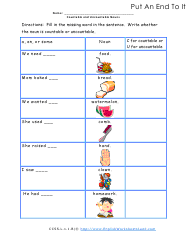Noun Worksheets
Nouns are the parts of speech that are used to name people, places, or things. They can also be used to define or explain a quality. If you are looking to name a specific person, place, or thing you would use a pronoun. Nouns are often the subject of all the sentences that we read or write. This makes them one of the most frequently used parts of speech. Nouns are the fundamental part of any sentence. They come in two varieties. Common nouns are used to represent general people, places, or things. Proper nouns pinpoint specific people, places, or things. We might use a common noun to say, "My teacher gave me detention!" We could make it more specific with a proper noun for our teacher by saying, "Mrs. Smith gave me detention!" We literally have hundreds of different worksheets on this topic and they go in all different directions. Take a look below to determine which category of worksheets best fits your need.
Appositives - These are often used as modifiers to help you better explain or detail something.
Collectives - These are used to designate a group of items, people, or places. You may be familiar with the example terms: herd, flock.
Common, Proper, and Possessive Nouns - This is a nice section because it covers a wide range of uses and students can explore all the different reasons, we use this part of speech.
Concrete Forms - Used to signify things that we can identify with one of our five human senses.
Countable and Uncountable - We often forget that not everything can be counted. They may be able to measured or quantified, but you cannot count everything.
-ES and -S Plurals - We learn how convert a singular form to the plural.
Frequently Used Nouns and Verbs - These are things we use in everyday language and speech.
Gender Nouns - These refer to something as being either male or female.
Genitive Case - This is primarily used to state a sense of possession. This is the good ole' apostrophe "s" or placing the word "of" prior to that part of speech.
Grammar and Mechanics - We focus on the structure that is used and the adherence to the rules of the English language.
Matching Verbs and Nouns in Sentences - This takes into account a wide range of grammar focused skills.
Nouns as a Direct and Indirect Objects - We learn to understand the use of objects within a sentence and learn how to use them to our advantage when writing.
Plural Forms - We show you how to go from one to many and then come back again.
Possessive Forms - We show you how to state ownership and identify when ownership has been demonstrated.
Proper Nouns - These are names that are used for a specific person, place, or thing. Remember to always capitalize them. This is often the biggest culprit for capitalization errors.
Quantifiers - This is when you choose to scale something up or down. We show you how to do this with the English language.
Regular and Irregular Plurals - We learn how to identify the usage and how to convert between them based on your need.
Singular Possessives - When you only have one that you are attaching ownership to.
Using Abstract Forms - These are used to signify intangible things that you cannot recognize with one of your five human senses.
Using Articles of Language - These help you clarify the object or state of your object within your sentences.
Using Collectives - We begin to explore how to express a group with a commonly shared interest.
Using Determiners - These can add a great deal of clarity to your writing when they are used properly.
Using Irregular Plural Nouns - It is all about switching up the spelling for this to work out.
Get FREE English Worksheets In Your Email
